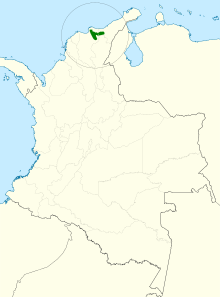Black-backed thornbill
| Black-backed thornbill | |
|---|---|

| |
| male | |
| Scientific classification | |
| Domain: | Eukaryota |
| Kingdom: | Animalia |
| Phylum: | Chordata |
| Class: | Aves |
| Clade: | Strisores |
| Order: | Apodiformes |
| Family: | Trochilidae |
| Genus: | Ramphomicron |
| Species: | R. dorsale
|
| Binomial name | |
| Ramphomicron dorsale | |

| |
The black-backed thornbill (Ramphomicron dorsale) is an Endangered species of hummingbird in the "coquettes", tribe Lesbiini of subfamily Lesbiinae. It is endemic to the Sierra Nevada de Santa Marta of northern Colombia.[3][4][1]
Taxonomy and systematics[edit]
The black-backed thornbill is monotypic. It shares its genus with the purple-backed thornbill (R. microrhynchum).[3]
Description[edit]
The black-backed thornbill is 9 to 10 cm (3.5 to 3.9 in) long and weighs about 3.5 g (0.12 oz). Both sexes have a very short black bill; the male's is slightly decurved. The male's upperparts are velvety black with purplish uppertail coverts and a white spot behind the eye. Their gorget is olive green and the rest of the underparts are a mix of dark gray and rufous with green dots. The tail is moderately long, deeply forked, and purplish black. Females have shining grass green upperparts, and like the male, purplish uppertail coverts and a white spot behind the eye. Their underparts are buffy white with green dots. The tail is shorter than the male's and the outer pair of feathers have white tips.[5]
Distribution and habitat[edit]
The black-backed thornbill is restricted to the isolated Sierra Nevada de Santa Marta in far northern Colombia, where it inhabits the edges of humid and elfin forest and also páramo. In elevation it ranges from 2,000 m (6,600 ft) as high as the snowline at about 4,600 m (15,100 ft).[5]
Behavior[edit]
Movement[edit]
The black-backed thornbill moves to lower elevations in May and Jun.[5]
Feeding[edit]
The black-backed thornbill forages for nectar at any height from the ground to the canopy. It has been recorded taking nectar from the flowers of Ericaceae, Lobeliaceae, Melastomataceae, and Rubiaceae, and more specifically flowers of genera Erythrina, Puya, and Salvia. It collects nectar while hovering and also by clinging to the flower. In addition it feeds on insects caught on the wing and gleaned from flowers.[5]
Breeding[edit]
Nothing is known about the black-backed thornbill's breeding phenology.[5]
Vocalization[edit]
The black-backed thornbill's calls include "a short dry rattle 'trrr'...a long descending rattle...'tsee-tttrrrrrrrr-tsee', [and] single 'tsee' notes."[5]
Status[edit]
The IUCN has assessed the black-backed thornbill as Endangered. It has a very limited range; its population size is not known and is believed to be decreasing. Its habitat is under severe human pressure for conversion to agriculture and grazing.[1] A small part of its range is protected in a national park.[5]
References[edit]
- ^ a b c BirdLife International (2016). "Black-backed Thornbill Ramphomicron dorsale". IUCN Red List of Threatened Species. 2016: e.T22687987A93178424. doi:10.2305/IUCN.UK.2016-3.RLTS.T22687987A93178424.en. Retrieved 23 February 2022.
- ^ "Appendices | CITES". cites.org. Retrieved 14 January 2022.
- ^ a b Gill, F.; Donsker, D.; Rasmussen, P., eds. (January 2022). "Hummingbirds". IOC World Bird List. v 12.1. Retrieved 15 January 2022.
- ^ HBW and BirdLife International (2020) Handbook of the Birds of the World and BirdLife International digital checklist of the birds of the world Version 5. Available at: http://datazone.birdlife.org/userfiles/file/Species/Taxonomy/HBW-BirdLife_Checklist_v5_Dec20.zip [.xls zipped 1 MB] retrieved 27 May 2021
- ^ a b c d e f g Züchner, T. and P. F. D. Boesman (2020). Black-backed Thornbill (Ramphomicron dorsale), version 1.0. In Birds of the World (J. del Hoyo, A. Elliott, J. Sargatal, D. A. Christie, and E. de Juana, Editors). Cornell Lab of Ornithology, Ithaca, NY, USA. https://doi.org/10.2173/bow.blbtho1.01 retrieved 23 February 2022


